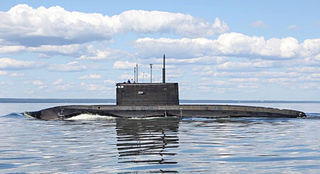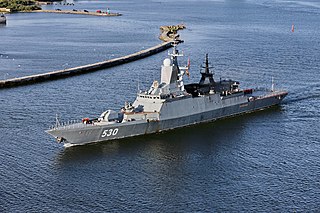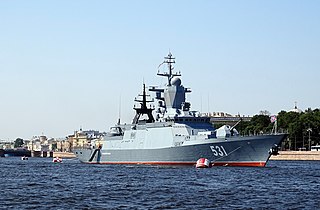
The Kilo class, Soviet designation Project 877 Paltus, NATO reporting name Kilo, is a class of diesel-electric attack submarines designed and built in the Soviet Union for the Soviet Navy. The class was built until the mid-1990s, when production was switched to the more advanced Project 636 Varshavyanka variant, also known as Improved Kilo class in the West.

The Steregushchiy class, Russian designation Project 20380, is a class of corvettes being built for the Russian Navy. Designed by the Almaz Central Marine Design Bureau, subsequent vessels were built to an improved design, incorporating the Zaslon-Redut SAM system. The ship full displacement and dimensions are large for a corvette, thus it is designated as a frigate by NATO. The Steregushchiy class has been further developed into the Gremyashchiy class and Project 20386 subclasses. The export variant is known as Project 20382 Tigr.

Russian cruiser Varyag, is the third ship of the Slava-class of guided missile cruisers built for the Soviet Navy now serving the Russian Navy.

The Admiral Gorshkov class, Russian designation Project 22350 for the original and upgraded version armed with 16 and 32 VLS cells respectively, is the newest class of frigates being built by the Severnaya Verf in Saint Petersburg for the Russian Navy with a cost of 250 mill.$. The Project 22350 was designed by the Severnoye Design Bureau and incorporates use of stealth technology. As of August 2020, ten vessels have been contracted for delivery by 2027. The lead ship of the class, Admiral Gorshkov, was commissioned on 28 July 2018.

The Buyan class, Russian designations Project 21630 Buyan and Project 21631 Buyan-M, are series of corvettes developed by Zelenodolsk Design Bureau for the Russian Navy. Since 2010, all subsequent vessels are being constructed as improved Project 21631 subclass, incorporating greater tonnage, stealth technology and the 3S14 vertical launching system for either Kalibr or Oniks anti-ship cruise missiles, significantly enhancing combat capabilities. The ships are primarily designed for operations within littoral zones to protect Russia's vast coastal areas. Due to the small tonnage, they can operate even within shallow parts of oceans and seas and Russia's river system. The export variant is known as Project 21632 Tornado.

Admiral Flota Sovetskogo Soyuza Gorshkov is an Admiral Gorshkov class frigate of the Russian Navy and the lead ship of the class.

Soobrazitelny is the second ship of the Steregushchy-class corvette built for the Russian Navy in the early 21st century.

The Alexandrit class, Russian designation Project 12700 Aleksandrit, is the newest class of Russian minesweepers designed by Almaz and being built by the Sredne-Nevsky Shipyard for the Russian Navy. The first ship was laid down on 22 September 2011 and was launched in June 2014. Anywhere between 30 and 50+ ships have been described as envisaged.

The Pacific Fleet is the Russian Navy fleet in the Pacific Ocean.

The Dyugon-class landing craft, or Project 21820, is a class of five air-cavity landing craft in service with the Russian Navy.

The Gremyashchiy class, Russian designation Project 20385, is an update of the Steregushchiy-class corvettes of the Russian Navy. This follow-on project was designed by the Almaz Central Marine Design Bureau in Saint Petersburg. The first ship was laid down on 26 May 2011 and the official laying down ceremony took place on 1 February 2012. Although classified as corvettes by the Russian Navy, these ships carry sensors and weapon systems akin to frigates and, as a result, are so classified by NATO.
Following the dissolution of the Soviet Union at the end of 1991, the Russian Navy struggled to adjust Cold War force structures while suffering severely with insufficient maintenance and a lack of funding. However, improvements in the Russian economy over the first decade of the twenty-first century led to a significant rise in defence expenditure and an increase in the number of ships under construction.

The Grachonok class, Russian designation Project 21980 Grachonok, is a class of anti-saboteur and large guard boats being built for the Russian Navy. The class is designed to combat sabotage and terrorist forces and means in the waters off bases and near the approaches to them, as well as to assist the Border Service of the Federal Security Service of the Russian Federation in solving the problems of preservation and protection of the state border of Russia. Twenty-four boats were built since 2008.

The Karakurt class, Russian designation Project 22800 Karakurt, is a new class of Russian corvettes which have been entering service with the Russian Navy since 2018.

Sovershennyy is a corvette in the Steregushchy-class in service with the Russian Navy. The ship was laid down in 2006 and launched in 2015. She commenced sea trials in early 2017 and joined the Russian Pacific Fleet on 20 July 2017. She was the first large surface warship to join the Pacific Fleet in 25 years.

Stoikiy is a Steregushchiy-class corvette of the Russian Navy.

Retiviy is a Steregushchiy-class corvette of the Russian Navy. The ship's name was reported to have changed to Mercury in 2021.

Gremyashchiy is the lead ship of the Gremyashchiy-class corvettes of the Russian Navy.

Hero of the Russian Federation Aldar Tsydenzhapov is a Steregushchiy-class corvette of the Russian Navy.






















